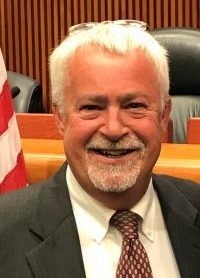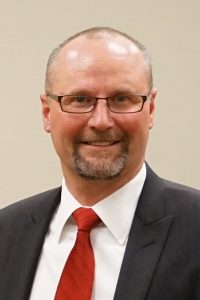What Will 2021 Look Like at The State Level? State Association Executives Have Plenty to Say About That.
By Mark S. Kuhar
In the aggregates industry, state associations are as close to the action as you can get. The executive directors of those associations have varied opinions on 2021 from the perspective of their members and regions of the country. Here are some of their comments.

New York
“New York’s aggregate industry had a slow start as the pandemic began in March but recovered when the government declared construction an essential business,” said Dave Hamling, president and CEO, New York Construction Materials Association. “That was vitally important since New York’s construction season is typically only eight months long. Many of our members reported robust demand as the season progressed. The industry took safeguards very seriously, to the point that I’m not aware of any confirmed COVID cases related to aggregate, asphalt or concrete production.
“NYSDOT did a good job of delivering the capital program during 2020 – for which we are grateful,” Hamling said. “However, we are very concerned about 2021 and, particularly, out years. Both the federal and state governments have enormous COVID bills to pay and we will need to push hard to make infrastructure funding a priority to lawmakers.
“Though unrelated to the pandemic, producers are concerned with the makeup of our state legislature. The senate, assembly and governor’s house are controlled by Democrats, with veto-proof supermajorities in both houses. The progressive agenda put forth in 2020 will continue into 2021 and threatens to put our industry in jeopardy, particularly in terms of environmental regulation. New York has not been friendly to business and industry – and that is likely worsen in 2021 and beyond. In summary, New York’s construction materials industry weathered the COVID storm pretty well in 2020, but there are serious concerns looking forward,” Hamling concluded.

Michigan
According to Douglas E. Needham, executive director of the Michigan Aggregates Association, Michigan is poised to spend more money on road repairs than ever before in 2021 because “we are consistently rated as having the worst roads in America, resulting in multiple funding initiatives,” he said. “Michigan’s 2015 road funding package will be fully implemented next year, and a new $3.5 billion state bonding program announced in January will result even more projects getting underway.
“COVID-19 has certainly been a concern to our industry. However, we adopted guidance from the CDC and other governmental orders to ensure we could continue to safely operate. The pandemic slowed the private markets at the beginning of year, but once Michigan was able to fully open up, the markets rebounded,” Needham continued.
“Thanks to our governor’s new bond selling program and our legislature for ensuring a fully funded transportation budget, Michigan is working hard to address our aging infrastructure. We are always ready to move forward,” Needham stated. “Michigan aggregate producers are working to meet the needs of Michigan markets, both under our current regulatory environment and by working to implement legislative reforms that would allow a much-needed expansion of aggregate mining in our state. This would inject more supply into the system and reduce costs in both the government and private markets. Our members are can-do people, allowing them to maintain an upbeat attitude during 2020. They are looking forward to a very vibrant and healthy 2021.
“While Michigan’s aggregate producers stand ready to address our state’s vast infrastructure needs in 2021, we are seeking reforms at the state level now to unlock access to aggregate supplies by removing the many roadblocks put in place by local units of government and NIMBY protesters,” Needham concluded.

Illinois
“2021 is expected to be a promising year in which our industry will play a crucial role in rebuilding Illinois,” said Dan Eichholz, executive director of the Illinois Association of Aggregate Producers. “Transportation has always been the backbone of the Illinois economy and in 2019 Illinois made a major investment in our future by passing a capital plan funded by transportation fee increases which has roughly doubled the Illinois DOT’s annual construction budget.
“We expect to see construction begin throughout the state on many major projects funded by the capital plan in 2021,” Eichholz continued. “We are fortunate that our industry was appropriately recognized as ‘essential’ from the outset of the pandemic and operations continued throughout 2020 with most members reporting business as ‘steady.’ However, like most industries, we have been impacted. Recent Illinois DOT lettings have been less robust than anticipated, particularly in the Chicago area, due to a pandemic-related shutdown of the court system leading to a backlog of right-of-way clearances. In addition, 2020 motor fuel tax receipts have come in under projections. Without federal funding for state DOT’s to backstop revenues that have been lost due to the pandemic, the State could see some projects delayed.”

Arizona
According to Steve Trussell, executive director pf the Arizona Rock Products Association, despite an unexpected pandemic, Arizona was prepared for a fiscal downturn it didn’t see coming. The state had approximately a billion dollars in the rainy-day fund. “That said, one might argue that most of this year would qualify as a ‘rainy day,” Trussell noted. “If you look back, the state had also identified sustainable funding sources for vital services such as education. Over the last half decade, Arizona has also increased dollars for priorities, while ensuring those programs are sustainable. In fact, in FY2004-FY2008 Arizona experienced an 11% average spending growth compared to FY2016-FY2020 when we saw only a 4.5% average spending growth in the state. Fiscal foresight and restraint played a key role in why Arizona is not suffering like other parts of the country.
“Since the pandemic began, state revenue collections have been much higher (20%) than anticipated and as many states consider drastic budget cuts, Arizona ended the most recent fiscal year with a $370 million surplus,” Trussell said. “Instead of cutting, Arizona is investing in key areas like K-12, by infusing an additional $440M for education in addition to funding already allocated in the FY2021 budget. That’s impressive given the current circumstances.
“While recent years have seen significant investments in specific areas of the state’s budget that are important to Arizonans, much of these expenditures were wisely handled with one-time spending, to avoid encumbering future legislatures with fiscal obligations. When it came time to pass the ‘skinny budget,’ in May of this year much of the previous one-time spending was not included. There was not a fight that legislators were cutting programs, as would have been the case if these expenditures were made ongoing. It is also notable that it was resolved by a bipartisan effort,” Trussell said.
“The one thing that has hurt Arizona in the recent election was the passage of Prop 208 or Invest in Education.” Trussell said. “This ballot initiative imposes a 3.5% surcharge (tax) on high income earners that equates to a 77% increase on the current rate that will cause Arizona to go from one of the most business-friendly states to uncompetitive for job creators depending on how they file their income tax returns.
“While we state Highway User Revenue Funds are higher than forecasted despite COVID, it is still not sufficient to meet the growing need in areas like Maricopa County,” Trussell said. “Additionally, since sales receipts are up the Regional Area Road Fund has been better than expected, but we are clearly in maintenance mode less one-time funding from the Arizona State legislature for one time transportation infrastructure projects.”

New Jersey
“In New Jersey we have definitely dodged the proverbial bullet,” said Bill Layton, executive director of the New Jersey Concrete and Aggregate Association. “Construction of all types from the very beginning of the pandemic has been open. While some projects have been impacted by the virus due to financing or market pressure for the most part New Jersey is chugging along.
“A few years back New Jersey passed an increase in our gas tax as well as an automatic cost of living adjustment every year. These changes put the Transportation Trust Fund on good footing providing funding for essential projects that have made the public side of Construction extremely vibrant,” Layton said. “While COVID has been a devastating disease, the industry is optimistic that with the vaccine right around the corner 2021 will be a great year.”

Ohio
“Ohio is fortunate to have implemented a motor fuel user-fee increase in 2019,” said Patrick A. Jacomet, executive director, Ohio Aggregates & Industrial Minerals Association (OAIMA). “We applaud the foresight of the governor, the ODOT director and the legislature leading to the important passage of this increase. Because of this additional funding, although Ohio was drastically impacted by reduced user-fee revenues due to COVID-19, it could have been much worse. The OAIMA board of directors and our members took a lead role in the passage of this increase through the formation of the ‘Infrastructure Funding Workgroup’ as well as their active engagement and lobbying efforts.
“ODOT has also been proactive and aggressive in budgeting for the decreased user-fee receipts,” Jacomet said. “The leadership of Director Marchbanks and the belt-tightening at ODOT has minimized the impact of reduced revenues. Although revenues on average have been down in 2020, primarily due to COVID-19, OAIMA members are ‘cautiously optimistic’ regarding the prospects for 2021 and overwhelmingly feel that additional funding is needed at both the state and federal levels. The majority of OAIMA Associate members are projecting increase equipment orders in 2021, while just over 70% of our members anticipate additional hiring in 2021.”

Kentucky
“We are optimistic 2021 will be a better year compared to 2020,” said Nicholas S. Rodgers executive director, Kentucky Crushed Stone Association. “We are hopeful our legislature will pass an increase in the user fee to help increase revenue for Kentucky’s Road Fund.
“Kentucky has certainly been hit hard by COVID-19. The Kentucky Transportation Cabinet (KYTC) canceled the April and May highway lettings and suspended nearly 100 resurfacing projects. The highway lettings did restart very slowly in June and have gotten a little better as the economy slowly recovered but have not returned to a pre-COVID-19 economy,” Rodgers stated.
“Kentucky’s Road Fund does not have enough revenue to properly meet the needs set forth by the Kentucky Transportation Cabinet (KYTC),” Rodgers concluded. “The KYTC has identified nearly $900 million dollars in new revenue needed to maintain, repair and expand our infrastructure. The Kentucky state legislature convenes again on Jan. 5, 2021, for a 30-day legislative session where they will have the opportunity to address this issue and increase the revenue sources.”

North Carolina
“I’m cautiously optimist[ic] that the producers in North Carolina will do better in 2021 than 2020 because this year the pandemic created a financial crisis for NCDOT,” said Jasper G. Stem Jr., executive director of the North Carolina Aggregates Association. “Highway lettings were suspended for six months. Hopefully, the non-public sector will continue to be strong. The urban areas are doing well. Rural areas are holding on.
“Since the construction/aggregate industry was considered an essential business in North Carolina, our members never had to shut down,” Stem said. “They did have to implement additional measures to protect their employees. As I stated above, the NCDOT’s cash balance dropped below the minimum threshold earlier this year, so all lettings were suspended from April to September. By cutting expenses and managing their revenues, the NCDOT has been able build up the cash balance, so they should be in better shape going into 2021. Their revenues are currently running about 2% above their projections.
“Concerning the long-term financial outlook, the Secretary of Transportation in 2019 commissioned a blue-ribbon panel to recommend sustainable long range investment strategies that will provide the necessary resources to build and maintain North Carolina’s future transportation system. In mid-January, their recommendations will be presented to the General Assembly for their consideration With NCDOT getting their financial house in order this year and legislation that places some guardrails on NCDOT spending, 2021 will definitely be a better year for the highway construction industry.”

Oregon
“Oregon had a busy 2020 construction season,” said Richard Angstrom, executive director of the Oregon Concrete and Aggregate Producers Association (OCAPA). “The governor’s executive order treated businesses differently than many other states. Oregon did not go down the ‘essential business’ route. The governor closed specific businesses and activities, but if it was not on the list she devised, a business was allowed to operate pretty much as usual with masking and social distancing considerations.
“Next year, 2021, OCAPA anticipates additional highway work from a state transportation revenue package passed in 2017, but the industry remains cautious on commercial development given spending pull back from COVID and Oregon’s ever increasing corporate tax structure. OCAPA’S biggest concern, from a high-level perspective, is whether Oregon’s government creates a supportive business climate to attract and retain businesses or it has created a system that represses business investment and disincentivizes business retention. If the state hasn’t crossed the line between the two considerations, it certainly is leaning toward the latter.”

California
“The producers have been through a lot of swings this year – adjusting to new circumstances, not knowing if they could continue to work, and then ultimately able to continue at a decent level. Our industry has been fortunate and able to supply material for a lot of important projects to improve roads, bridges, hospitals, and schools. Society will come back to a better built environment. While public works should keep us going in the near term, there are a lot of unanswered questions about how society may change from the pandemic and what this means for unmet needs of housing, and the future of building and school construction, and more,” said Robert Dugan, president and CEO of the California Construction and Industrial Materials Association (CalCIMA).
“We were fortunate that in 2017 California enacted SB 1, the Road Repair and Accountability Act. The SB 1 added $5 billion per year in revenue for state and local road and bridge repair and reconstruction. Over the past fiscal year, that money started to reach fruition in the form of new projects and expenditures. While revenues have been impacted slightly from less driving, it has yet to delay projects significantly and revenues seem to be ticking back up. We are fortunate, too, that a lot of counties have passed their own sales taxes for transportation, which helps keep projects moving.
“We are hoping for a relatively flat year trending down slightly,” Dugan said. “Despite recent health orders from the governor and county governments in response to surges in COVID-19 this fall, they have allowed construction and manufacturing activities to continue and therefore the supply chain, including the construction and industrial materials markets, to continue operating.
“Overall, it is anticipated that private markets on the construction side will continue to decline, but our primary revenue drivers for public works, specifically gas, sales and excise taxes have not been hit as hard as it was originally anticipated and the state’s transportation fund went into the downturn with a healthy reserve,” Dugan noted.
“More specifically, producers see a backlog and pipeline of projects coming on the first half of the year that will at least keep business activity near the past year. While public works seem solid, the housing and building markets are not as robust. There will likely be more activity in the urban coastal than the more rural inland areas. The main uncertainty is about the 2nd half of the year and the lasting impacts of the pandemic,” Dugas concluded.

Georgia
“Aggregate producers in Georgia are positive about business in 2021,” stated Jeff Wansley, executive director of the Georgia Construction Aggregates Association. “The economy in Georgia is strong, thanks to our governor who kept the business climate up and running in our state. State revenues are on track and DOT projects are rolling out. New business is coming to Georgia as well.
“We are also encouraged by potential legislation in the Georgia General Assembly that will fund new freight and logistics projects in the state. The state legislature conducted a two-year study with the Ga Freight and Logistics Commission. This group will be releasing findings and recommendations that we hope will become positive infrastructure funding,” Wansley said.
“COVID-19 has been challenging in our industry and our state as it has all over the country. However, we are thankful that we have a pro-business government that has kept the ball rolling despite the terrible tragedy that the pandemic brought to our country. Compared to many states, Georgia ‘dodged a bullet’ as it relates to conducting business this year,” he said.
“Fortunately, Georgia’s DOT funding is not in dire straits. Funding mechanisms that support highway building have remained strong during the year,” Wansley stated. “The general mood among aggregate producers is positive in Georgia. There is the continued frustration of the constraints that COVID-19 places on people and businesses – and concessions you have to make for safety protocol, but most have pivoted and adapted to the new environment. As mentioned, we are in a pro-business state with strong leadership geared to staying the number one state in which to do business. The positive mood also permeates to our associate members who support our industry in Georgia. Many associate members have told me that they are having their best year on record.”
